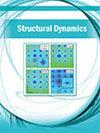Condensation of ground state from a supercooled phase in the Si(111)-(4 × 1) → (8 × 2)-indium atomic wire system
IF 2.3
2区 物理与天体物理
Q3 CHEMISTRY, PHYSICAL
引用次数: 2
Abstract
Strong optical irradiation of indium atomic wires on a Si(111) surface causes the nonthermal structural transition from the (8 × 2) reconstructed ground state to an excited (4 × 1) state. The immediate recovery of the system to the ground state is hindered by an energy barrier for the collective motion of the indium atoms along the reaction coordinate from the (4 × 1) to the (8 × 2) state. This metastable, supercooled state can only recover through nucleation of the ground state at defects like adsorbates or step edges. Subsequently, a recovery front propagates with constant velocity across the surface and the (8 × 2) ground state is reinstated. In a combined femtosecond electron diffraction and photoelectron emission microscopy study, we determined—based on the step morphology—a velocity of this recovery front of ∼100 m/s.Si(111)-(4 × 1)→(8 × 2)-铟原子线体系中过冷相的基态冷凝
铟原子线在Si(111)表面上的强光辐照导致从(8) × 2) 重建基态到激发态(4 × 1) 州。系统立即恢复到基态受到铟原子沿着反应坐标从(4)集体运动的能垒的阻碍 × 1) 至(8 × 2) 州。这种亚稳的过冷状态只能通过吸附质或台阶边缘等缺陷处基态的成核来恢复。随后,恢复锋以恒定速度在地表和(8 × 2) 地面状态恢复。在飞秒电子衍射和光电子发射显微镜的联合研究中,我们根据台阶形态确定了这种恢复前沿的速度为~100 m/s。
本文章由计算机程序翻译,如有差异,请以英文原文为准。
求助全文
约1分钟内获得全文
求助全文
来源期刊

Structural Dynamics-Us
CHEMISTRY, PHYSICALPHYSICS, ATOMIC, MOLECU-PHYSICS, ATOMIC, MOLECULAR & CHEMICAL
CiteScore
5.50
自引率
3.60%
发文量
24
审稿时长
16 weeks
期刊介绍:
Structural Dynamics focuses on the recent developments in experimental and theoretical methods and techniques that allow a visualization of the electronic and geometric structural changes in real time of chemical, biological, and condensed-matter systems. The community of scientists and engineers working on structural dynamics in such diverse systems often use similar instrumentation and methods.
The journal welcomes articles dealing with fundamental problems of electronic and structural dynamics that are tackled by new methods, such as:
Time-resolved X-ray and electron diffraction and scattering,
Coherent diffractive imaging,
Time-resolved X-ray spectroscopies (absorption, emission, resonant inelastic scattering, etc.),
Time-resolved electron energy loss spectroscopy (EELS) and electron microscopy,
Time-resolved photoelectron spectroscopies (UPS, XPS, ARPES, etc.),
Multidimensional spectroscopies in the infrared, the visible and the ultraviolet,
Nonlinear spectroscopies in the VUV, the soft and the hard X-ray domains,
Theory and computational methods and algorithms for the analysis and description of structuraldynamics and their associated experimental signals.
These new methods are enabled by new instrumentation, such as:
X-ray free electron lasers, which provide flux, coherence, and time resolution,
New sources of ultrashort electron pulses,
New sources of ultrashort vacuum ultraviolet (VUV) to hard X-ray pulses, such as high-harmonic generation (HHG) sources or plasma-based sources,
New sources of ultrashort infrared and terahertz (THz) radiation,
New detectors for X-rays and electrons,
New sample handling and delivery schemes,
New computational capabilities.
 求助内容:
求助内容: 应助结果提醒方式:
应助结果提醒方式:


